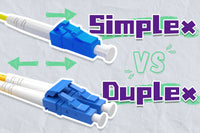From streaming to cloud computing, personal users and businesses largely rely on high-performance networks. To meet the demand for high-speed and large-capacity data transmission, fiber optic cables have been widely used today. Dense wavelength division multiplexing (DWDM) is a key technology in optical fiber systems, playing an indispensable role in many applications. Have you ever come across DWDM but don’t know what it entails? This article reveals some essentials that you should know about DWDM.
What is DWDM?
Before diving into DWDM, it’s important to first understand wavelength division multiplexing (WDM). Multiplexing is a technique that allows multiple signals to share the same physical transmission medium by combining them into one. Traditionally, an optical fiber can only carry one optical carrier signal, while WDM technology enables the simultaneous transmission of different optical carrier signals on a single fiber by activating multiple wavelengths. This can effectively maximize the use of existing network infrastructure and reduce network complexity.
DWDM is one of the main types of WDM. Dense WDM relies on accurate and stable lasers to achieve tightly spaced wavelength divisions. It provides a maximum number of channels, each with a distinct optical wavelength. This essentially creates multiple virtual optical fibers to carry data, greatly increasing fibers’ overall data-carrying capacity.
DWDM uses wavelengths in the C-band (1530 nm to 1565 nm), and has been extended to the L-band (1565 nm to 1625 nm), typically featuring wavelength spacing of 0.4 nm or 0.8 nm. DWDM can support 40, 88, 96, or even 160 wavelengths in C-band and L-band. As a technology to achieve high-bandwidth transmission, DWDM can achieve transmission distances of over 1000 km paired with optical amplifiers. It provides an ideal solution for long-distance, high-capacity, and high-speed data communications.
How Does DWDM Work?
The working process of DWDM can be very complex and here is a brief overview to help you grasp the basics. DWDM works by combining multiple optical signals with different wavelengths into a single fiber using multiplexers. Multiplexers can handle high-density wavelengths to ensure they are precisely aligned. Sometimes the optical amplifiers are used during signal transmission over long distances, reducing signal degradation. At the receiving end, the demultiplexer is used to separate this combined signal into individual optical signals with different wavelengths, and then transmits these signals to target destinations.

Working Modes of DWDM
DWDM can achieve full-duplex transmission through dual fibers or single fibers. In a unidirectional DWDM system, each fiber transmits optical signals in only one direction, meaning that two separate fibers are required - one for sending and the other for receiving. Dual-fiber transmission ensures no interference, and the same wavelength can be used on the two fibers. Bidirectional DWDM enables both transmission and reception of signals on a single fiber using different wavelengths for each direction. The single-fiber bidirectional communication saves fiber and optical component resources, while it requires greater precision and more advanced equipment.
DWDM System Components
A DWDM system comprises some essential components that work together to achieve high-bandwidth and large-capacity data transmission. Here is the breakdown of some key components:
- DWDM Transceiver: This optical transceiver plays a crucial role in the fiber optic system. It is a combination of transmitter and receiver. The transmitter component converts the input electrical signals into optical signals at precise wavelengths and sends them to the multiplexer; the receiver component receives demultiplexed optical signals and converts them into electrical signals.
- DWDM Mux and Demux: Before the signal enters the fiber, the Mux serves to converge optical signals of different wavelengths into a single beam of light. The Demux is used at the end of the DWDM transmission to separate the light beam back into various wavelengths. Wavelength division multiplexers are typically passive devices that implement multiplexing and demultiplexing in a two-way communication system.
- Optical Amplifier: A fiber can generally transmit data over 80 km, which is sometimes not long enough for DWDM uses. An optical amplifier is needed in a DWDM system to extend its transmission distance. Common DWDM optical amplifiers include erbium-doped fiber amplifiers (EDFA) and Raman amplifiers.
- Optical Add/Drop Multiplexer (OADM): An optical add-drop multiplexer can be used in the DWDM link to add or drop optical signals with specific wavelengths. This device simplifies the installation, makes the DWDM network more flexible and enhances its scalability.
- Optical Transponder: It is usually located between the DWDM system and users’ ends. The optical can convert one wavelength to another wavelength ideal for specific applications through an optical-electrical-optical (O-E-O) conversion process.

Benefits of DWDM Technology
- Super Bandwidth: DWDM can accommodate more than a hundred channels, which remarkably increases the bandwidth. The data capacity of each fiber cable in DWDM can reach terabits per second
- Long-distance Transmission: DWDM uses wavelength bands with minimal signal loss, greatly extending the transmission distance. DWDM can be used for metropolitan, multinational and even intercontinental data communications, facilitating global connectivity via fiber optic networks.
- Scalability: DWDM offers great scalability for fiber networks, enabling easy expansion of new services or capacity by adding new wavelengths. In addition, with future technology upgrades, DWDM can expand a wider range of wavelength options and provide higher bandwidth.
- Cost-effectiveness: Implementing DWDM systems significantly reduces the cost per bit of data. Moreover, integrating DWDM system components into existing fiber optic infrastructures can reduce additional fiber deployment, construction and labor costs.
- Reliability: DWDM is protocol and data rate independent, enabling transmitting data streams with completely different rates, formats and characteristics simultaneously via a single fiber. There is no interference between different streams and each wavelength in the DWDM operates independently, ensuring data integrity and stability. DWDM supports dynamic reconfiguration of optical wavelength channels and provides additional line redundancy, so the network can achieve self-recovery.
Passive DWDM vs. Active DWDM
Passive DWDM operates without any active devices like optical amplifiers. It is composed of passive OADM and Multiplexers/Demultiplexers. Its transceivers are often embedded in switches. These DWDM systems are suitable for high-speed communication lines and metropolitan area networks. Though they offer simple installation, cost-effectiveness, and low maintenance, they are less flexible and scalable.
Active DWDM is a more self-contained system that uses active components such as EDFA and DCM to enhance the signal and compensate for distortion. Designed for long-haul networks, these systems can accommodate more wavelengths and offer easy control and scalability. However, they can be more costly and complex to configure.
DWDM Applications
As a relatively advanced optical transmission technology, DWDM supports a wide range of applications, including data center networks, long-haul transmission, and metropolitan area networks (MANs).
DWDM systems allow for long-distance transmission across cities, regions and even countries. The DWDM system enables service providers to offer cable and wireless internet. It supports packetized voice and streaming multimedia. In metropolitan area networks, two of the most important applications of DWDM are SANs and SONET migration.
DWDM greatly simplifies network management in dense data centers by supporting simultaneous delivery of audio, video, and data. Managed and cloud service providers rely on DWDM’s high bandwidth. DWDM also plays an important role in data center interconnect (DCI), facilitating high-capacity transmission over long distances.
Note: DWDM and CWDM
Coarse wavelength division multiplexing (CWDM) is another mainstream WDM technology that operates in the 1271-1611 nm band. It is similar to DWDM, but the wavelength channels are more coarsely divided with a larger wavelength spacing typically of 20 nm. As a result, CWDM can only fit up to 18 channels, which is much smaller in capacity compared to DWDM. CWDM does not provide compatibility with optical amplification technology, so its transmission distance is limited and only suitable for short-distance applications such as enterprise DCI and metropolitan areas.
As a simpler and more economical technology, CWDM features lower deployment costs and can accommodate less accurate fibers and components, making it suitable for initial network construction. In contrast, DWDM is a future-oriented solution, supporting more wavelength channels, higher rates and bandwidths, longer transmission distances. DWDM is narrowing its budget disadvantage over CWDM, and it is worth investing in when you need more growth potential.
Conclusion
The DWDM system enhances the fiber optic transmission by multiplexing numerous wavelengths of light. With its ability to provide ultra-high capacity and long-distance transmission, DWDM occupies an irreplaceable place in the field of fiber optic communications.
For more information on this topic, you can keep up on our blogs. While VCELINK offers general and basic information for our customers and other visitors to the website, it’s not professional advice.



Be the first one to comment.
Leave a comment